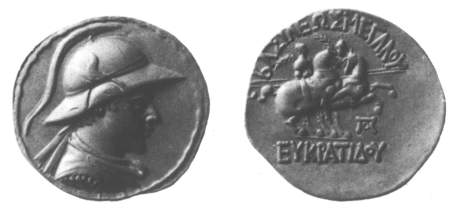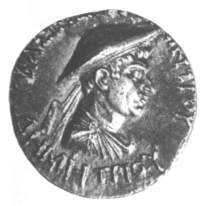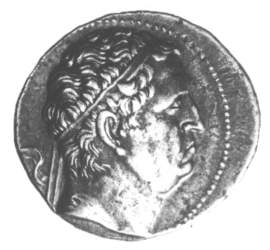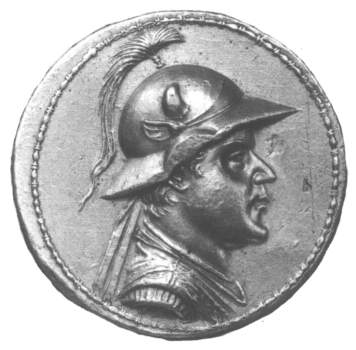Amazon Audible Gift Memberships

Shop Amazon - Create an Amazon Baby Registry
Bactrian Coins
Click for larger images of these Bactrian Coins
Illustrations 113-116, pp132-133 in Tamara Talbot Rice, Ancient Arts of Central Asia, 1965
113, 114, 115, 116 These four examples illustrate the quality of Bactria's coins.
From left to right are shown the obverse and reverse of Eucrarides' silver tetradrachma, c. 180-150 BC,
with on one side the king's head and on the other the Dioscuri on horseback; Demetrius helmeted on his silver tetradrachma of the late third century BC;
the usurper Euthydemus in old age. c, 230 BC, on his silver tetradrachma and, finally, Eucratedes' gold stater, c. 170-65 BC, the largest gold coin now in existence
113 Coin: Eucratedes and (reverse) two horses. Silver tetradrachma, c. 180-150 BC. Photo: Courtesy Trustees of the British Museum
114 Coin: Demetrius helmetted. Silver tetradrachma of Demetrius. Photo: Courtesy Trustees of the British Museum
115 Coin: Euthydemus in old age. Silver tetradrachma wearing a laurel wreath, c. 230. Photo: Courtesy Trustees of the British Museum
116 Coin: Eucratedes. Gold stater. Bactrian, 170-165 BC. Photo: Bibliothèque Nationale, Paris
pp. 132-133
Though the presence of Greek artists in Bactria cannot as yet be proved, it alone can account for the firmness with which the Hellenistic tradition took root there.
Still today in the village of Istalaf, situated some 30 kilometres to the south-west of Kabul, the founding of which is ascribed by tradition to a group of Greek potters,
clay figurines are being spontaneously made in the archaic Greek style.
Furthermore, in early Seleucid times no one but Greeks would have thought of providing Bactria with the superb coinage which now ranks as one of her chief glories,
and only Greek artists would have been able at that time to satisfy the demand for one of so high a quality.
Many Bactrian coins rank with the finest in existence (Ills. 114, 115, 116).
They possess an elegance, forcefulness and perfection of line which, together with the excellence of their minting, characterize the loveliest coins of Greece.
In addition certain of them show so great a gift for portraiture that they recall the best Roman sculptures.
To be numbered with these is one showing Eucratides wearing a topee-like helmet which makes him resemble a young nineteenth-century English officer of the Indian army with,
on the reverse, the Dioscuri riding horses that may well have been bred in Ferghana (Ill. 113).
Could Bucephulus have been of that breed? Bactria's nickel and copper coins are as well minted and designed as her gold and silver ones.
Foucher is surely right in thinking that they must have been produced by Greek master craftsmen, who may well have employed local men as assistants.
See also Phalera with Bactrian War Elephant and Crew Going Leftwards. State Hermitage Museum, St. Petersburg. S-64.
and Phalera with Bactrian War Elephant and Crew Going Rightwards. State Hermitage Museum, St. Petersburg. S-65.









